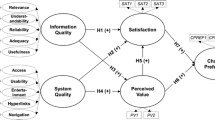Abstract
The Technology Acceptance Model (TAM) has been considered to be fundamental in determining the acceptance of new technology in the past decades. The two beliefs, ease of use and usefulness, in the model may not, however, fully explain the consumers’ behavior in an emerging environment, such as mobile commerce (m-commerce). This paper aims to develop a framework for m-commerce adoption in consumer decision-making processes. In this paper TAM has been adopted and extended to analyze successful m-commerce adoption. The key elements of the proposed confidence-based framework for B2C m-commerce adoption include psychological and behavioral factors. Psychological factors include history-based confidence, institution-based confidence and personality-based confidence. Behavioral factors include perceived ease of use and perceived usefulness of the mobile application and technology.



Similar content being viewed by others
References
Al-Gahtani S (2001) The applicability of TAM outside North America: an empirical test in the UK. Inf Resour Manage J 14
Bauer H, Barnes S, Reichardt T, Neumann M (2005) Driving customer acceptance of mobile marketing: a theoretical framework and empirical study. J Electron Commer Res 6(3)
Becker M (2005, 11/Nov) Effectiveness of mobile channel additions and a conceptual model detailing the interaction of influential variables. Retrieved 11/2/06, from http://www.iloopmobile.com/news/mb_research_111705.htm.
Davis FD (1989) Perceived usefulness, perceived ease of use, and user acceptance of information technology. MIS Q 13:319–340
Davis FD, Bagozzi RP, Warshaw PR (1989) User acceptance of computer technology: a comparison of two theoretical models. Manage Sci 35:982–1003
Doney PM, Cannon JP (1977) An examination of the nature of trust in buyer–seller relationships. J Mark 61(2):35–51
Extended systems (2002) Moses cone health system: hospital’s mobile it strategy improves patient care, delivers fast ROI, http://www.extendedsystems.com/
Finland: mobile marketing reaches nearly half of Finns (2005, 16/Dec). Retrieved 11/2/06, from eFinland: http://www.e.finland.fi/netcomm/news/showarticle.asp?intNWSAID=45302
Gallaugher J (1999) Challenging the new conventional wisdom of net commerce strategies. Commun ACM 42:27–29
Gefen D (2000) E-commerce: the role of familiarity and trust. Omega 28:725–737
Gefen D, Karahanna E, Straub DW (2003) Trust and TAM in online shopping: an integrated model. MIS Q 27:51–90
Hoffman DL, Novak TP, Peralta M (1999) Building consumer trust online. Commun ACM 42:80–85
Jarvenpaa SL, Tractinsky N, Vitale M (2000) Consumer trust in an Internet store. Inf Technol Manage 1:45–71
Lander MC, Purvis RL, McCray GE, Leigh W (2004) Trust-building mechanisms utilized in outsourced IS development projects: a case study. Inf Manage 41:509–528
Louis PJ (2001) M-Commerce crash course, McGraw-Hill, Boston
Mayer R, Davis J, Schoorman D (1995) An integration model of organizational trust. Acad Manage Rev 21:709–734
McKnight DH, Cummings L, Chervany N (1998) ‘Initial trust formation in new organizational relationships’, academy of management. Acad Manage Rev 23:473–490
McKnight DH, Choudhury V, Kacmar CJ (2002) Developing and validating trust measures for e-commerce: an integrative typology. Inf Syst Res 13:334–359
Oliver RL, DeSarbo WS (1988) Response determinants in satisfaction judgments. J Consum Res 14:495–507
Papadopoulou P, Andreou A, Kanellis P, Martakos D (2001) Trust and relationship building in electronic commerce. Internet Res 11:322–332
PEAR —Personalized Mobile Advertising Services (2006, 1/Feb) Finnish customers welcome mobile marketing—press release. Retrieved 11/2/06, from http://www.pear.fi/english/pr.php?p1=1
Reibstein DJ (2002) What attracts customers to online stores, and what keeps them coming back? Acad Mark Sci 30:465–473
Reichheld F, Schefter P (2000) E-Loyalty—your secret weapon on the web. Harv Bus Rev 78:105–113
Roussos G, et al (2002) A case study in pervasive retail. Proceedings of the second international workshop on mobile commerce, Atlanta, Georgia, USA. ACM, New York
Steele R, Tao W An enhanced architecture for mobile retailing. Accepted to the international conference on mobile technology, applications and systems (IEE mobility 2006), 25–27 October, Bangkok, Thailand
Tang F, Thom MG, Wang LT, Tan JC, Chow WY, Tang X (2003) Using insurance to create trust on the Internet. Commun ACM 46:337–344
Tao W, Steele R (2006) Mobile trust via extended digital certificates, accepted to the second IEEE international symposium on dependable, autonomic and secure computing (DASC 06), Indianapolis, USA, Sep 29–Oct 1, 2006
Teo SH, Liu J (2005) Consumer trust in e-commerce in the US, Singapore and China. Int J Manage Sci Omega 1–17
Torkzadeh G, Dhillon G (2002) Measuring factors that influence the success of Internet commerce. Inf Syst Res 13:187–204
Widing R, Sheth JN, Pulendran S, Mittal B, Newman BI (2003) Customer behavior: consumer behavior and beyond. Thomson learning, Melbourne
Wingreen S, Baglione S (2005) Untangling the antecedents and covariates of e-commerce trust: institutional trust versus knowledge-based trust. Electron Mark 15:246–260
Wei J, Ozok A (2005) Development of a web-based mobile airline ticketing model with usability features. Ind Manage Data Syst 15:1261–1277
Wong YK, Hsu CJ (2005) Enhancing e-Commerce Success—a model driven approach. Proceedings of the european management and technology conference, Rome, Italy, 20–21 June
Wong YK, Hsu CJ, Steele R (2005a) Technology acceptance model (TAMCom) for Kristiansand business to customer (B2C). Proceedings of the IRIS’28 conference, Norway, 6–9 Aug
Wong YK, Rubasinghe A (2005) Security issues and management: biometric technology acceptance. Proceedings of the European management and technology conference, Rome, Italy, 20–21 June
Wong YK, Rubasinghe A, Steele R (2005b) An empirical research program for biometric technology adoption. Proceedings of the IRIS’28 conference, Kristiansand, Norway, 6–9 August
Worldwide mobile market forecasts 2006–2011 (2006, 18/Jan). Retrieved 11/2/06, from Portio research: http://www.portioresearch.com/WMMF06–11.html
Author information
Authors and Affiliations
Corresponding author
Rights and permissions
About this article
Cite this article
Wong, Y.K., Hsu, C.J. A confidence-based framework for business to consumer (B2C) mobile commerce adoption. Pers Ubiquit Comput 12, 77–84 (2008). https://doi.org/10.1007/s00779-006-0120-5
Received:
Accepted:
Published:
Issue Date:
DOI: https://doi.org/10.1007/s00779-006-0120-5




